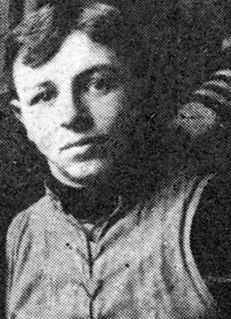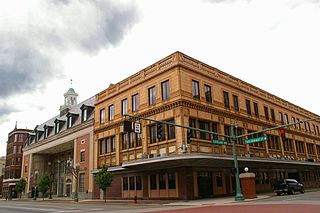The Cleveland Bulldogs were a team that played in Cleveland, Ohio in the National Football League. They were originally called the Indians in 1923, not to be confused with the Cleveland Indians NFL franchise in 1922. However, after team owner Samuel Deutsch purchased the Canton Bulldogs in 1924, he merged the Canton team with his Indians and renamed his franchise the Cleveland Bulldogs. The Canton Bulldogs remained a part of the team until 1925, when they were sold back to Canton. The Cleveland Bulldogs played in the NFL until 1928 when they were relocated to Detroit and became the Detroit Wolverines. The team was later incorporated into the New York Giants in 1929. The Cleveland Bulldogs won the 1924 NFL championship.
The Cleveland Tigers were the first Cleveland, Ohio team franchise in what became the National Football League (NFL). The Tigers played in the "Ohio League" before joining the American Professional Football Association during the 1920 and 1921 seasons.
The Salt Lake City Bees were a minor league baseball club, based in Salt Lake City, Utah from 1911 until 1984, under various names. The Bees were long-time members of both the Pacific Coast League and Pioneer League. The team played their home games at Derks Field.

Martin Francis Hogan, nicknamed "The Indianapolis Ringer", was an Anglo-American right fielder in Major League Baseball who played for the Cincinnati Reds (1894) and St. Louis Browns (1894–1895). After leaving the National League, Hogan moved on to the minor league Indianapolis Hoosiers. Some sources suggest he set a national baserunning record in the 1890s.

The Youngstown Ohio Works baseball team was a minor league club that was known for winning the premier championship of the Ohio–Pennsylvania League in 1905, and for launching the professional career of pitcher Roy Castleton a year later. A training ground for several players and officials who later established careers in Major League Baseball, the team proved a formidable regional competitor and also won the 1906 league championship.
The Youngstown Steelmen was a minor league baseball franchise that competed in three different leagues between 1910 and 1915. The club, based in Youngstown, Ohio, participated at various times in the Ohio–Pennsylvania League, the Tri-State League, and the Central League. The Steelmen's most notable alumnus was Everett Scott, who played with the club between 1910 and 1913. Scott later served as a shortstop for the Boston Red Sox and New York Yankees.
Homer Hurd Davidson was a professional Major League Baseball player for the Cleveland Naps. Born in Cleveland, Ohio, he played only 6 games for the Naps during the 1908 season. Davidson was better known as a professional football player. He played in the Ohio League, which was the direct predecessor to the modern National Football League. One veteran Ohio sportswriter once rated Davidson to be the equal of Walter Eckersall, an infamous quarterback from the University of Chicago. He attended college at the University of Pennsylvania and played on the Penn Quakers baseball team.
The Canton Bulldogs–Massillon Tigers betting scandal was the first major scandal in professional football in the United States. It refers to a series of allegations made by a Massillon, Ohio newspaper charging the Canton Bulldogs coach, Blondy Wallace, and Massillon Tigers end, Walter East, of conspiring to fix a two-game series between the two clubs. One account of the scandal called for Canton to win the first game and Massillon was to win the second, forcing a third game—with the biggest gate—to be played legitimately, with the 1906 Ohio League championship at stake. Another account accused Wallace and East of bribing Massillon players to throw a game in the series. Canton denied the charges, maintaining that Massillon only wanted to damage the club's reputation. Although Massillon could not prove that Canton had indeed thrown the second game and it remains unknown if there was ever a match-fixing agreement, the scandal tarnished the Bulldogs name and reportedly helped ruin professional football in Ohio until the mid-1910s.
The Massillon Tigers were an early professional football team from Massillon, Ohio. Playing in the "Ohio League", the team was a rival to the pre-National Football League version of the Canton Bulldogs. The Tigers won Ohio League championships in 1903, 1904, 1905, and 1906, then merged to become "All-Massillons" to win another title in 1907. The team returned as the Tigers in 1915 but, with the reemergence of the Bulldogs, only won one more Ohio League title. Pro football was popularized in Ohio when the amateur Massillon Tigers, hired four Pittsburgh pros to play in the season-ending game against Akron. At the same time, pro football declined in the Pittsburgh area, and the emphasis on the pro game moved west from Pennsylvania to Ohio.

George Watson "Peggy" Parratt was a professional football player who played in the "Ohio League" prior to it becoming a part of the National Football League. Born in Cleveland, Ohio, Parratt played for quarterback for the Shelby Blues, Lorain Pros, Massillon Tigers, Massillon All-Stars, Franklin Athletic Club of Cleveland, Akron Indians and the Cleveland Tigers between 1905 and 1916. Parratt threw the first legal forward pass in professional football history while playing for the Massillon Tigers on October 25, 1906.

The Nesser brothers were a group of American football-playing brothers who helped make up the most famous football family in the United States from 1907 until the mid-1920s. The group consisted of seven brothers who worked for Panhandle Division of the Pennsylvania Railroad in Columbus, Ohio, and who were later used as the foundation for the Columbus Panhandles of the Ohio League, and later the National Football League, when the club was founded by future NFL president Joe Carr in 1907.

George W. Bausewine was an American professional baseball pitcher and umpire in Major League Baseball (MLB). He umpired in the National League during the 1905 season. He had previously been a pitcher in professional baseball, and he spent part of one season pitching in MLB for the Philadelphia Athletics.
The Coleman Athletic Club of Akron was a professional American football team based in Akron, Ohio in 1913. The team played in the Ohio League and was formed when C.P. Parker, secretary of the baseball's Akron Giants, of the Interstate League, formed a new Akron-based football team to compete with Peggy Parratt and his Indians. Parker first convinced a few of Parratt's regulars to sign with his club. He then loaded the rest of roster with ex-players from the Elyria Athletics, which had just folded a week prior.
The McKeesport Tubers was the name of several minor league baseball teams located in McKeesport, Pennsylvania between 1890 and 1940.
The Akron Champs was the dominant name of a minor league baseball team that represented Akron, Ohio between 1905 and 1920.
The Steubenville Stubs was the predominant name of a minor league baseball team that sparsely played in Steubenville, Ohio between 1887 and 1913. The team was first formed in 1887 as a member of the Ohio State League, before disbanding on June 29 of that year. A second Stubs team played in 1895 as a member of the Interstate League, however that team also proved to be short-lived. The club moved to Akron, Ohio on May 10, 1895 to become the Akron Akrons and then to Lima, Ohio on May 19, 1895 to become the Lima Farmers.
The Sharon Giants was the predominant name of a minor league baseball team based in Sharon, Pennsylvania that existed between 1905 and 1912. The team played all of its seasons in the Ohio–Pennsylvania League.
The Newark Newks was the predominant name of a minor league baseball team based in Newark, Ohio from 1905 until 1915. The team was first known as the Newark Idlewilds and began playing in the Ohio–Pennsylvania League. In 1906 the club changed its name to the Newark Cotton Tops. Finally in 1907, the team took on the Newks name. In 1908 the team moved in the Ohio State League, where they played until 1911. On June 22, 1911, the team moved to Piqua, Ohio to become the Piqua Picks. However that June, the Grand Rapids Furniture Makers of the Central League moved to Newark and became the Newark Skeeters. The next season the Skeeters played in the Ohio State League and posted a 72–68 record before vanishing. The city fielded the Newark New Socks in the 1915 Buckeye League before folding permanently.
The Mansfield Pioneers was a name used by a minor league baseball club, based in Mansfield, Ohio, and played periodically between 1887 and 1912. The team first began play in the Ohio State League in 1887 as simply Mansfield. The following season, the club moved to the Tri-State League until 1890. After a three-year hiatus, Mansfield once again fielded a new team, the Mansfield Electricians and played the 1893 season in the short-lived Ohio–Michigan League. No team was then fielded until 1897, when the city fielded the Mansfield Haymakers in the Interstate League.
The Canton Bulldogs were a professional American football team, based in Canton, Ohio. They played in the Ohio League from 1903 to 1906 and 1911 to 1919, and the American Professional Football Association, from 1920 to 1923 and again from 1925 to 1926. The Bulldogs would go on to win the 1916, 1917 and 1919 Ohio League championships. They were the NFL champions in 1922 and 1923. In 1921–1923, the Bulldogs played 25 straight games without a defeat, which as of 2018 remains an NFL record. As a result of the Bulldogs' early success along with the league being founded in the city, the Pro Football Hall of Fame is located in Canton. Jim Thorpe, the Olympian and renowned all-around athlete, was Canton's most-recognized player in the pre-NFL era.





